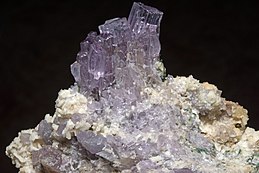
Scapolite

The scapolites (Gr. σκάπος, rod, and λίθος, stone) are a group of rock-forming silicate minerals composed of aluminium, calcium, and sodium silicate with chlorine, carbonate and sulfate. The two endmembers are meionite (Ca4Al6Si6O24CO3) and marialite (Na4Al3Si9O24Cl). Silvialite (Ca,Na)4Al6Si6O24(SO4,CO3) is also a recognized member of the group. The scapolites (Gr. σκάπος, rod, and λίθος, stone) are a group of rock-forming silicate minerals composed of aluminium, calcium, and sodium silicate with chlorine, carbonate and sulfate. The two endmembers are meionite (Ca4Al6Si6O24CO3) and marialite (Na4Al3Si9O24Cl). Silvialite (Ca,Na)4Al6Si6O24(SO4,CO3) is also a recognized member of the group. The group is an isomorphous mixture of the meionite and marialite endmembers. The tetragonal crystals are hemihedral with parallel faces (like scheelite), and at times of considerable size. They are distinct and usually have the form of square columns, some cleavages parallel to the prism-faces. Crystals are usually white or greyish-white and opaque, though meionite is found as colorless glassy crystals in the ejected limestone blocks of Monte Somma, Vesuvius. The hardness is 5–6, and the specific gravity varies with the chemical composition between 2.7 (meionite) and 2.5 (marialite). The scapolites are especially liable to alteration by weathering processes, with the development of mica, kaolin, etc., and this is the cause of the usual opacity of the crystals. Owing to this alteration, and to the variations in composition, numerous varieties have been distinguished by special names. Scapolite is commonly a mineral of metamorphic origin, occurring usually in crystalline marbles, but also with pyroxene in schists and gneisses. The long slender prisms abundant in the crystalline marbles and schists in the Pyrenees are known as dipyre or couzeranite. Large crystals of common scapolite (wernerite) are found in the apatite deposits in the neighborhood of Bamble near Brevik in Norway, and have resulted from the alteration of the plagioclase of a gabbro.
